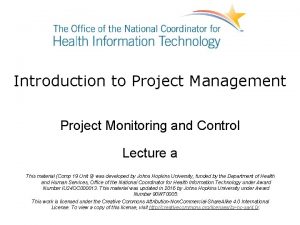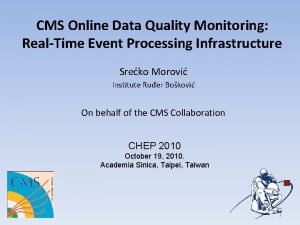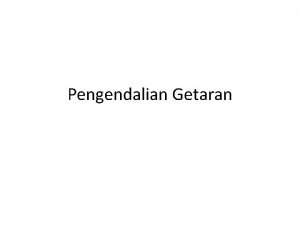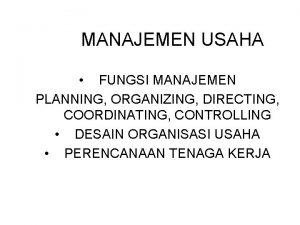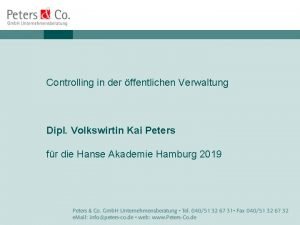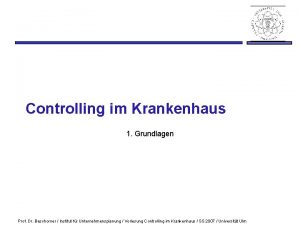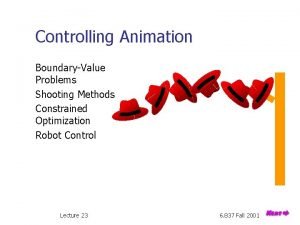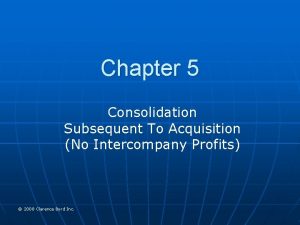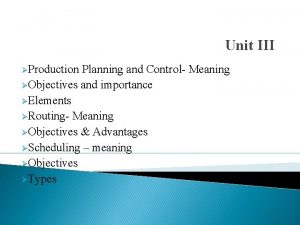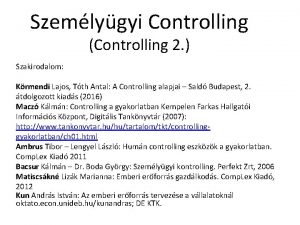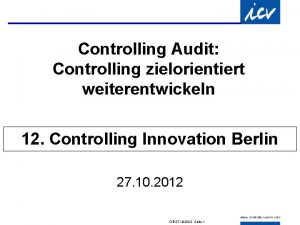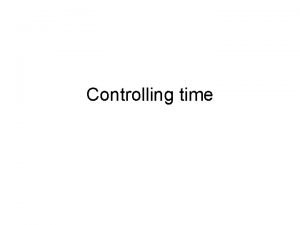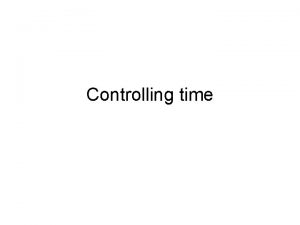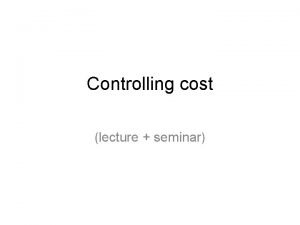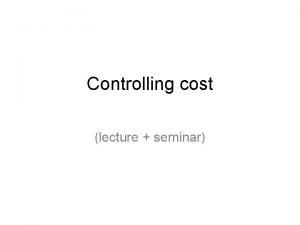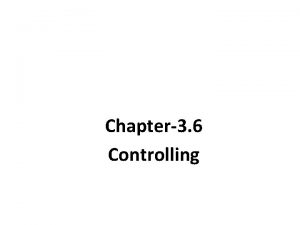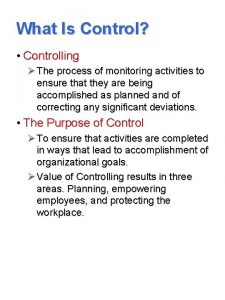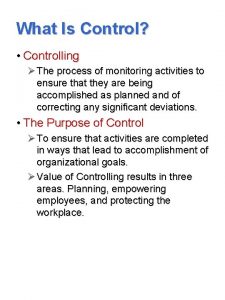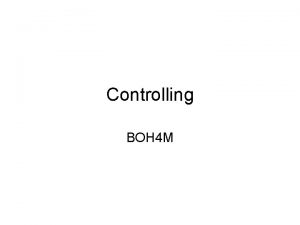Controlling time lecture seminar Why to control Monitoring





































- Slides: 37

Controlling time (lecture & seminar)

Why to control? Monitoring and analysis of project data should enable the project manager to • address problems at an early stage and • take advantages of opportunities; • prevent problems rather than responding to them; • communicate quickly and effectively: thus project members will work with the same and up-todate information, and can quickly deal with problems.

6 essential features of control systems 1. A plan must be made 2. This plan must be published 3. Once working, the activity being controlled must be measured 4. The measurements must then be compared with the plan 5. Any deviations must be reported to the appropriate person 6. A forecast of the results of any deviations must then be made, and corrective actions taken or a new plan must be made Bar chart PNTs

Measurement of activities 1. The measurement should be appropriately precise 2. The measurement should be pertinent 3. The speed of collection of the information must be rapid compared with the timecycle of the system as a whole 4. Measurements need to be accurate or of consistent inaccuracy 5. The number of data processing points should be kept as small as possible

The measurement should be appropriately precise • Precision is positively correlated with measurement costs • PNT indicates the necessity of precision – Critical activities – Non-critical activities

The measurement should be pertinent • What use the collected data can be made

The speed of data collection… • Measurement must be taken frequently enough to allow useful action to be taken. • The longer the time for corrective actions to be taken, the lower frequency of measurement is acceptable. • Thus: the speed of data collection will increase toward the project’s ending.

Measurements need to be accurate or of consistent inaccuracy • Accuracy can be bought with increased cost. • Inaccurate but consistent measuring technique can be acceptable. • PNT: where is the low accuracy tolerable. • Accuracy and precision is NOT the same: Accuracy = degree of closeness to the true value (validity) Precision = degree to which repeated measurements leads to the same results (reliability).


The number of data processing points should be kept as small as possible Too much processing points would lead to: • delay in information use • distortions in the information

3 useful methods (the simplest while appropriate is the best) • The bar (Gantt) chart or the network itself • Re-analysis • Negative float

Gantt chart as a time control method (best for smaller projects) Activities time 1. 2. 3. 4. 5. 6. today

Example Market research (survey) project. Estimation of activity durations: 1. Creating the SOW (framework for the research). = 7 days 2. Collecting secondary information: 1. models = 15 days 2. empirics = 15 days 3. 4. 5. 6. 7. 8. 9. Planning the research = 6 days Formulating the questionnaire = 14 days Collecting data in 3 destinations form 100 -100 people = 10 days each Entering data = 2 days per one subsample Analysing data = 6 days Writing up the research report = 7 days Presenting the results = 1 day

Example After 30 days: • SOW is made in 7 days • Secondary research on models was finished in 14 days • Secondary research on empirics was finished in 18 days • Half of the research plan is written • No other activity is started

Re-analysis with PNT (or with Gantt chart) • In large and/or complex projects. • Taking the original network and inserting into the actual times instead of the expected durations. Sometimes new „delay activites” need to be built in. OR • Re-drawing the network leaving out all those activities that are complete and re-analyse the others. (Just like planning a new project)

Example 2 (for networks) • Manufacturing project: The firm have to purchase two types of raw materials (A & B; procurement is centralised thus it is a single activity), and produce two different product parts from these (P 1 and P 2). These can be done separately. P 2 has to put through an obligatory test, P 1 do not. After both P 1 and P 2 are ready, the firm will assemble them with an externally bought P 3 part (this must be purchased after previous buying is closed) to get the final product. Project done. Create the WBS and identify tasks.

Example 2 (sipmlified network diagram) The duration times for the activities (with activity labels): • (a) Raw materials procurement: 7 days • (b) P 1 production: 5 days • (c) P 2 production: 2 days • (d) P 2 test: 2 days • (e) P 3 procurement: 4 days • (f) Assembly: 2 days b 5 • Network? • TPT? a 7 c 2 d 2 e 4 a-b-f = 14 = TPT a-c-d-f = 13 a-e-f = 13 f 2

Example 2: problems arise • After the project started, it became obvious that the testing facility will not be able to start the testing process in time, only two days later (they have a priority job for another project). • The P 3 procurement is expected to be 1 day longer, too. • Re-analyse the project with the network. • Identify the new TPT. b 5 a 7 c 2 delay 2 e 5 a-b-f = 14 a-c-(delay)-d-f = 15 = TPT a-e-f = 14 d 2 f 2

Negative float • If the network is too large and complex. • Fix the end date, insert the actual durations and re-analyse the network (backward analysis). • Late activities will appear with negative float. There must be corrective actions taken (priority is according to the order of the absolute value of the negative floats).

Example 2: calculate floats and negative floats 0 b 5 0 a 7 1 1 c 2 d 2 0 f 2 1 0 e 4 b 5 -1 -1 a 7 c 2 delay 2 d 2 This will be discussed in a more sophisticated way on the following classes, after we learn more about the project network diagrams. 0 e 5 -1 f 2

Reporting rules • Avoid recrimination (‘past is dead’). Take steps to avoid a recurrence of failure not to create a fuss. • Progress should be reported in the form: – not complete • How much time is required to complete the activity? – complete • PNT helps to identify problematic areas and distinguishes areas of authority but not remove any responsibility.

Forecasting with PNT • It enables predictions of resultant actions to be deduced from present or past actions.

Forecasting example with PNT Planned total project time (PTPT) of 1000 days. After 400 days (ATWP) the planned time for the work performed (PTWP) is 350 days. a) What is the estimated time to complete (ETC) the project? b) What is the estimated time slip for the whole project? c) Calculate the schedule performance index (SPI). • •

Solution • Planned time to complete (PTC): PTPT – PTWP = 1000 - 350 = 650 days • From the past activities we can calculate how these days have to be recalculated if the performance is not changing: ATWP/PTWP = 400/350=8/7 • Current estimated time to complete (ETC): 650*(8/7)=743 • Current estimated TPT: 400+743=1143 • Total current estimated time slip: 1000 -1143=-143 • Current schedule performance index (SPI): PTWP/ATWP=350/400=0. 875=87. 5%

Plotting the limits of performance level

Problem solving There is a project with a planned Total Project Time (TPT) of 120 days. The project consist of three non-overlapping work packages with a duration of 40 -40 days each. After 20 days only 37. 5% of the first work package is completed. Calculate the following: • current schedule performance index (SPI) • total current estimated time slip • planned time to complete • current estimated time to complete (ETC) • current estimated Total Project Time (TPT)

Reading • Textbook chapter 9

Thank you for listening

Seminar

Seminar problem 1 • There is a project consisting of 4 tasks: – – A (duration: 3 days) starts at the 1 st day B (1 day) starts at the 4 th day C (2 days) starts at the 5 th day D (2 days) starts at the 7 th day • After 4 days the completition rates are: A (66. 67%), B (100%), others (0%) • Identify/Calculate the following: PTPT, ATWP, PTWP, SPI, PTC, ETPT, expected time slip • Plot the original and the re-analyzed Gantt charts.

Solution • • • Plot the Gantt (done in the seminar). PTPT = 8 days ATWP = 4 days PTWP = work units done expressed in days = 3 days SPI = (work done)/(work scheduled) = ¾ = 75% PTC = PTPT – PTWP = 5 days ETC = PTC/SPI = 6. 67 days ETPT = PTPT/SPI = 10. 67 days expected time slip = PTPT – ETPT = -2. 67 days

Seminar problem 2 • There is a project consisting of 5 tasks: – – – A (duration: 2 days) starts at the 1 st day B (3 days) starts at the 3 rd day (completing A is a prerequisite) C (2 days) starts at the 6 th day (completing B is a prerequisite) D (1 day) starts at the 8 th day (completing C is a prerequisite) E (2 days) starts at the 9 th day (completing D is a prerequisite) • After 5 days the completition rates are: A (100%), B (100%), C (50%), others (0%) • Identify/Calculate the following: PTPT, ATWP, PTWP, SPI, PTC, ETPT, expected time slip • Plot the original and the re-analyzed Gantt & PNT charts.

Solution • • • Plot the charts (done in the seminar). PTPT = 10 days ATWP = 5 days PTWP = work units done expressed in days = 6 days SPI = 6/5 = 120% PTC = PTPT – PTWP = 4 days ETC = PTC/SPI = 3. 33 days ETPT = PTPT/SPI = 8. 33 days expected time slip = PTPT – ETPT = +1. 67 days

Seminar problem 3 • There is a project consisting of 6 tasks: – – – A (duration: 1 day) starts at the 1 st day B (2 days) starts at the 1 st day C (3 days) starts at the 3 rd day (A&B are prerequisites) D (3 days) starts at the 3 rd day (A&B are prerequisites) E (3 days) starts at the 6 th day (C&D are prerequisites) F (1 day) starts at the 9 th day (E is a prerequisite) • After 5 days the completition rates are: A (100%), B (100%), C (33. 33%), others (0%) • Plot: PNT, Gantt (before and after) • Identify/Calculate the following: PTPT, ATWP, PTWP, SPI, PTC, ETPT, expected time slip

Solution • • • Plot the Gantt chart (solved in the class) PTPT = 9 days ATWP = the number of calendar days spent on the project = 5 days SPI = (work units completed)/(work units planned during the 5 days)= = PTWP/ATWP = 4/9 ≈ 44. 44% PTWP = how many calendar days should it have taken to complete the work units completed during the ATWP = = ATWP(SPI) = = (average planned duration of a work unit)(work units performed) = = (4/9)(5) = 20/9 ≈ 2. 22 days of work with 100% schedule performance PTC = PTPT – PTWP ≈ 6. 78 days ETC = PTC/SPI = 15. 25 days ETPT = PTPT/SPI = ATWP + ETC = -20. 25 days expected time slip = PTPT – ETPT = -11. 25 days

Seminar problem 4 (’treasure map’) • The project is the following: 1 st a treasure map should be decoded (activity a, 2 weeks). After it is done, the location of the treasure is identified, thus we can hire the staff (activity b, 2 weeks), buy the equipment (c, 1 week) and arrange transportation (d, 1 week). These tasks can be performed independently of each other. The next step is travelling to the site (e, 1 week). Last part is the excavation (f, 4 weeks). • Plot the PNT diagram. Identify the paths, the critical path(s), the critical activities, the TPT, and the activity floats. • Plot the Gantt chart. • After 3 weeks, a is ready, c is ready, but nothing else. • Identify/calculate PTPT, ATWP, SPI, PTWP, PTC, ETPT, expected time slip. • Re-draw the Gantt and the PNT charts.

Solution • • • Plots are done in the seminar. PTPT = 9 weeks ATWP = 3 weeks SPI = 3/5 = 60% PTWP = 1. 8 weeks (= 12. 8 days) PTC = PTPT – PTWP = 7. 2 weeks ETC = PTC/SPI = 12 weeks ETPT = PTPT/SPI = 15 weeks expected time slip = PTPT – ETPT = -6 weeks
 Hey bye bye
Hey bye bye Project management monitoring and controlling
Project management monitoring and controlling 01:640:244 lecture notes - lecture 15: plat, idah, farad
01:640:244 lecture notes - lecture 15: plat, idah, farad Don't ask why why why
Don't ask why why why Internal control images
Internal control images Start time, end time and elapsed time
Start time, end time and elapsed time Continuous control monitoring definition
Continuous control monitoring definition Continuous control monitoring tools
Continuous control monitoring tools Control loop performance monitoring
Control loop performance monitoring Real time data quality monitoring
Real time data quality monitoring Sql developer unit testing
Sql developer unit testing Thesis statement controlling idea
Thesis statement controlling idea The controlling idea or central insight of a story
The controlling idea or central insight of a story Whats a controlling idea
Whats a controlling idea Planning organizing directing and controlling are the
Planning organizing directing and controlling are the Acquisition of non-controlling interest
Acquisition of non-controlling interest Tranzactii uzuale in sap
Tranzactii uzuale in sap Planning directing controlling
Planning directing controlling Pengendalian getaran
Pengendalian getaran Controlling idea adalah
Controlling idea adalah Disposal of fullness in garments
Disposal of fullness in garments Planning organizing directing controlling
Planning organizing directing controlling Who are managers
Who are managers Caitln counter
Caitln counter What is the theme of controlling
What is the theme of controlling Non controlling interest
Non controlling interest Controlling idea 예시
Controlling idea 예시 Gfebs cost controlling definition
Gfebs cost controlling definition Controlling kennzahlen öffentliche verwaltung
Controlling kennzahlen öffentliche verwaltung Operatives controlling krankenhaus
Operatives controlling krankenhaus Constancy of condition
Constancy of condition Methods of controlling animation
Methods of controlling animation Acquisition of non-controlling interest
Acquisition of non-controlling interest Traditional techniques of controlling
Traditional techniques of controlling Cje accounting
Cje accounting The devices for controlling harmonic distortions are
The devices for controlling harmonic distortions are Production plan meaning
Production plan meaning Controlling a gyakorlatban
Controlling a gyakorlatban

